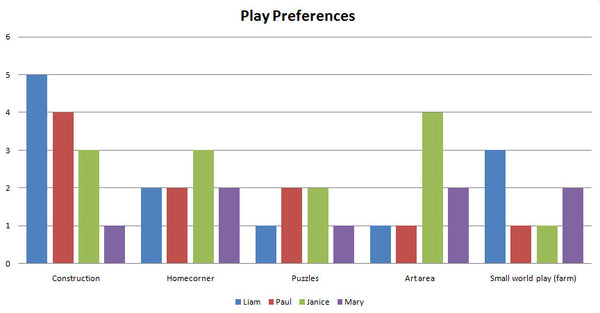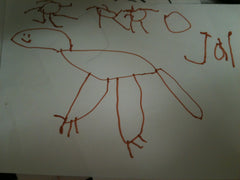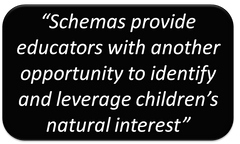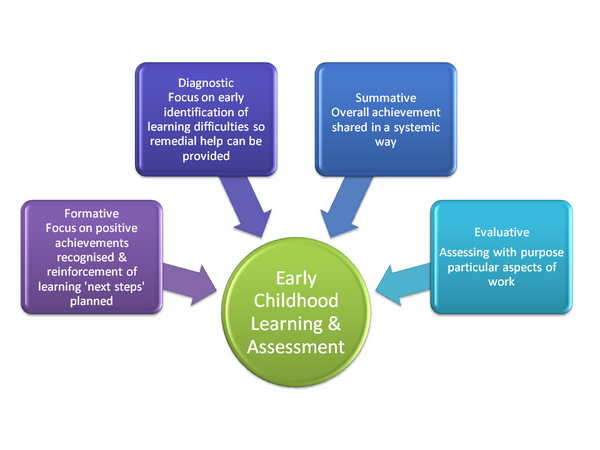Anecdotal Observations
An anecdote is a "short account of a particular incident or event of an interesting or amusing nature", often biographical ("Anecdote",nd). Anecdotes are useful for taking quick, simple notes that have been observed throughout the day. They are generally written in past tense and can be written up after the event when a teacher has more time. When taking an anecdotal observation it is good to note the time, date, place & relevant context of the event (eg. location, background information, children involved etc.). Essentially an anecdote tells story of what the observer has seen. As in all story telling, there are no strict rules for how this is done, however, it is worthwhile pointing out that observers should avoid using too much interpretation within their observation as this could inhibit subsequent reflection, particularly when reviewing a number of observations together at a later time.
PROS: Quick & can be remembered and written in past tense
CONS: Less objective
Example:
Date: 1/11/2010 Time: 9:15am Observer: Natalie Location: Main Playground Child/Children: Jai (4.1 yrs) Liam (4 yrs)
Anecdotal Observation:
Jai and Liam were playing "cooking" in the sandpit. Jai filled up his pots with sand whilst Liam stirred up a batch of rocks and sand at the toy stove. Jai said "Liam can you bake my cake". Liam said "in a minute...my cake's not done yet". Jai said "Can I see?" and he went over to the stove to see Liam's pot. "My cake has chocolate in it...see" Liam points to the mix. Jai giggles..."Yum" and grabbed a handful of the mix and pretended to eat it whilst dropping the sand to the ground. Liam laughed "You can't do that...you have to wait till it is cooked!"
Interpretation (What learning is occurring):
Liam and Jai have developed a good friendship and are interacting together well. This activity showed that they enjoy dramatic pretend play of an activity they probably have both observed at home.
Opportunities:
To leverage Jai & Liam's interesting in cooking into a mathematical cooking experience for counting and weighing ingredients.
Diary/Journal/Reflective Observations & Portfolios
These are fantastic way of building up a picture of the whole child, the activities they participated in and their interests. Typically consisting of a compilation of photographs, work samples and summaries of the day. I particularly find them useful in group observations or integrating group observations with the individual. In many cases children (and families) can become involved in the portfolios production and in such cases it is important that the observations focus on the child's strengths.
They can be time consuming and normally require regular compilation (although not compulsory).
PROS: Simple & visually attractive - great for presentation and collaboration with families. Very good, especially when preparing group observations on a computer, for preparing and easily reproducing across a large group of children.
CONS: Can be time consuming (as presenting aesthetically can be a challenge)
Developmental Progress Assessments/Check-lists
Many educators, myself included, have now accepted that normally developing early learning is helped little by undertaking developmental check list observations, where the focus is less on encouraging the educator to observe and build upon differing emerging strengths of individual children; which can appear at widely varying times, even amongst children of similar ages. However, whilst not beneficial in supporting and fostering normal 'individual' learning, it does have a place in early identification and confirmation of concerns in developmental delay and ultimately is highly beneficial in ensuring early intervention strategies are applied in a case where developmental delay is confirmed and long term outcomes are then improved. It can also be a helpful tool to prompt/remind/guide educator on potentially developmentally/age appropriate activities.
PROS: Very good for identifying/confirming developmental delay and improving long term outcomes for a child where early intervention strategies are subsequently implemented. Can also be good for prompting educators to challenge children to move to try new activities because it is developmentally appropriate.
CONS: Poorly supports 'strength based' learning and if it is a key or only technique applied, can limit opportunities to build upon children's differing emerging abilities.
Cultural Maps
The impact of family and culture on children and ultimately their learning is immeasurable. Understanding and supporting children and families, their culture and their learning will greatly improve educator ability to identify positive learning opportunities for children. Cultural maps are written and/or visual records of culture. Some examples elements of culture that could be included on a cultural map include: religion, belief, ethnic, knowledge, family immediate and extended, social demographics, food preferences, dress preferences etc. Cultural maps provide not only an amazing resource of knowledge and understanding for educators but also an amazing opportunity for children and families to participate in the process and exploration of their own culture.
PROS: Very good for identifying/confirming developmental delay and improving long term outcomes for a child where early intervention strategies are subsequently implemented. Can also be good for prompting educators to challenge children to move to try new activities because it is developmentally appropriate.
CONS: Poorly supports 'strength based' learning and if a key or only technique applied can limit opportunities to build upon children's differing emerging abilities.
Social Maps/Sociograms
Socio grams are a great way to illustrate communication and interactions of a child or children within a group and their friendship preferences. Generally speaking they are normally presented visually with key references to describe the different elements on the 'map'. Sometimes it might be helpful to overlay with other factors such as the physical layout of an environment, the presence of adults and other relevant influences to see if interactions are affected by these factors.
An example
Event Samples
Event sampling is a useful technique for observing behaviours, in particular for identifying the causes and possible consequences of certain behaviours, triggers and interactions.
Event sampling is normally recorded using the "ABC" technique:
- A for Antecedent (possible triggers, behaviours, actions) immediately prior to the event;
- B for the Behaviour (a summary of the observed behaviour)
- C for the Consequences (what happened immediately after the behaviour/event.
An example of an event sample which may be recorded using
this method includes observing each time a child exhibits signs of aggressive
behaviour and any causal factors. The knowledge gained from this observation
would then likely be helpful in terms of identifying possible triggers.
PROS: Facilitates effective collection of information to help inform teachers of possible triggers for an event/behaviour
CONS: Time (Requires planning & preparation). Sometimes difficult to capture all that has occurred, particularly prior to an event.
Example:
Date: 1/11/2010 Time: 9:15am Observer: Natalie Location: Main Playground Child/Children: Jai (4.1 yrs) Liam (4 yrs)
Observation:
| A |
B |
C |
| Jai & Declan are playing blocks. Jai is building a tower. Declan gets up and asks Jai to come with him to play on the lego table. Jai does not respond. Declan come up behind Jai and wraps his arm around Jai. Jai cries "don't...you hurt me"..Declan says sorry but still pulls at Jai..."come on". Declan pulls Jai over. |
Jai looks up and pushes Declan away. Declan falls over and cries. Delcan gets up and runs to a teacher..."Jai pushed me" |
Jai turns away..."Declan hurt me"...Jai walks to the book corner on the other side of the room. Declan follows sits down beside Jai. Two minutes later both boys are smiling again.
|
Interpretation:
Jai and Declan are learning how to make decisions and direct theirs and others play. In this circumstance Declan was unable to physically force Jai to another activity.
Opportunities:
To encourage discussion and/or read a story about listening and sharing (of your time/toys etc.)
Learning Stories
Learning stories are illustrative narratives about children's learning which involves all the stakeholder who are involved and/or support children's learning, including children, educators & families. "Learning stories shows a child’s progress over time and tend to be a more engaging form of reporting. The stories also provide valuable information which can be used to establish strong links between home and the care environment, and provide parents with an insight into what happens when the child is in care" (Ryan, K. nd)
Learning stories evolved from New Zealand's Te Whariki curriculum and over time have been simplified into three key questions:
1. Describe the learning
2. Review the learning
3. What's next (what will the stakeholders do to further support or enhance the learning)
Another technique typically used in learning stories is the recording of 'voices' of each stakeholder including:
- the child's voice
- the educator's voice
- the families voice
Some great online samples I have found include:
PROS: Detailed, fun, engaging to children, educators and families alike
CONS: Very time consuming, requires coordination and can focus too much on the images captured and the story told than on the learning
Running Records/Narrative Observations
These are very detailed descriptions of an event or behaviour which is recorded as it happens. They are recorded in present tense and provide step by step commentary of what is observed. They can be very helpful for closely analysing interactions or a child's progress at acquiring particular skill/learning. Typically a running record records time in increments, although this is not always the case. The key objective is to be very detail and factual about what you see, recording things that at the time may seem meaningless, but could later help an observer breakdown or better understand the learning that is occurring.
PROS: Detailed, objective and can really assist a teacher to understand a child's behaviour or progress
CONS: Time consuming, observation must be taken as it is being observed
Example:
Date: 1/11/2010 Time: 9:15am Observer: Natalie Location: Main Playground Child/Children: Jai (4.1 yrs) Liam (4 yrs)
Observation
(9:15am) Jai is sitting in the sandpit. He is using a shovel in his right hand to dig sand and pour loose sand into a old cooking pot. He groans and digs again, lifts the spade (losing half of the sand) and pours into the pot. He digs again and lifts a scoop of damp sand and lifts it to the pot (his arm wobbles but he does not drop the sand). He swaps hands and digs with his left hand, but lifts the spade with his right hand (dropping sand again). Jai groans. Jai shovels the sand again with his right arm. Jai drops the shovel and pats the sand with his left hand and then his right. He picks up the shovel with his left hand, scoops a large scoop (wobbles and drops some sand) as he puts into his pot. He pats the sand again with this right hand and reshovels with his left hand.
(9:19am) Jai looks up to see his friend Liam at the toy stove. He is watching Liam stir his pot.
(9:21am )Jai says "Liam can you bake my cake". He gets up then squats and picks up his pot. Jai carries it to Liam. Jai drops the pot on the table with a heaving sigh. Liam looks at Jai and smiles and says "in a minute...my cake's not done yet". Jai walks over to the stove and looks in Liam's pot. He is on his tippy toes Jai says "Can I see?". "My cake has chocolate in it...see" Liam points to the mix. Jai giggles..."Yum" and grabs a handful of the mix, stepping away from the pot (about 3 paces) and pretends to eat it. The sand mix falls to the ground, Jai steps back as it falls. Jai walks forward with his hand reaching for the mix again (Jai is smiling). Liam steps in front of his pot (Liam is smiling) "You can't do that...you have to wait till it is cooked!"
Interpretation:
Liam and Jai have developed a good friendship and are interacting together well. This activity showed that they enjoy dramatic pretend play of an activity they probably have both observed at home.
Jai shows a preference for using his right arm/hand but is experimenting with his left.
Opportunities:
To leverage Jai & Liam's interest in cooking into a mathematical cooking experience for counting and weighing ingredients.
To provide other gross motor activities to build strength in Jai's left arm.
Time Samples
Time sampling is effectively the recording of a child's activities/behaviour at pre-determined regular intervals during the day. Typically time samples are conducted half hourly but the frequency can be as often or infrequent as is appropriate to the child and situation. Time samples can be very helpful in monitoring child's interactions, particularly if that child is quiet and overlooked or always shows a preference for only a few particular activities.
PROS: Quick snap shots of a child's day, great for identifying possible triggers of certain behaviours
CONS: Time consuming, observation must be taken as it is being observed
Example:
Date: 1/11/2010 Time: 9:15am-12:15 Observer: Natalie Location: Various Child/Children: Jai (4.1 yrs)
Observation
| Time |
Location |
Activities |
Interactions |
| 9:15am |
Main Playground |
Sandpit/Cooking Pretend Play |
Liam |
| 9:45am |
Main Playground
|
Dinosaur pit (rocks and plastic dinosaurs) |
Liam & Lachlan |
| 10:15am |
Main Playground |
Climbing Equipment |
Liam |
| 10:45am |
Kindergarten Room |
Mobilio |
Liam |
| 11:15am |
Kindergarten Room |
Blocks |
Declan |
| 11:45am |
Kindergarten Room |
Dress ups |
Liam & Lachlan |
| 12:15am |
Kindergarten Room |
Computer |
Liam |
Interpretation:
Liam and Jai have developed a good friendship and are interacting together well, choosing to spend a large part of their day together.
Jai shows a preference for active, dramatic and construction play.
Opportunities:
To leverage Jai enjoyment of pretend play (with LIam) into other activities he has not been observed yet to take an interest in such as art (eg. creation of spaceman/robot outfits using boxes, paint etc.)
Tallies
Tallies can be great ways to quickly capture information such as:
- individual or group engagement in a particular activity;
- how many times/how often a situation, question or issue arises;
- differing opinions of children or groups of children
A clipboard, with your tallied item on noted, can easily and quickly capture your tally and then be drawn up into a simple bar graph or pie chart.
Some examples:

PROS: Can provide an insight into preferences not immediately evident at the time
CONS: Time consuming, need to be consistent in recording or results will be misleading
Work Samples, Photographs & Folios
Work samples of children's work can provide concrete evidence of children development overtime. In the same way as learning stories, diary notes etc., they also provide an opportunity for children, families and educators to share and appreciate the learning as it is occurring. Pictures can tell a thousand words and are one of the simplest ways a educator can quickly capture and review learning at a later date. Educators can make notes at the time of taking either on the work sample or picture about what the children said or did at the time, which also further enhance opportunities for later reflection and insight.
Example:

February 2011
Jai's "Monster with big claws...Grrrrahh!"
Jai is just starting to write his own name from memory and is experimenting with writing other letter he is forming into his own picture of words
PROS: Simple, quick, make fantastic and engaging displays or reports to take home
CONS: Need to go back later and reflect on learning, need camera and/or way to easily store work samples, unless adequate information is captured at the time too, can be misleading about learning that has or has not occurred.
References
"Anecdoate" (n.d) retrieved 7 November 2010 from Dictionary.com
Ryan, K. "Learning stories" (nd.) retrieved 26 February 2011 from
http://www.familydaycare.com.au/forms/feature%2041%20-%20Learning%20Stories.pdf







